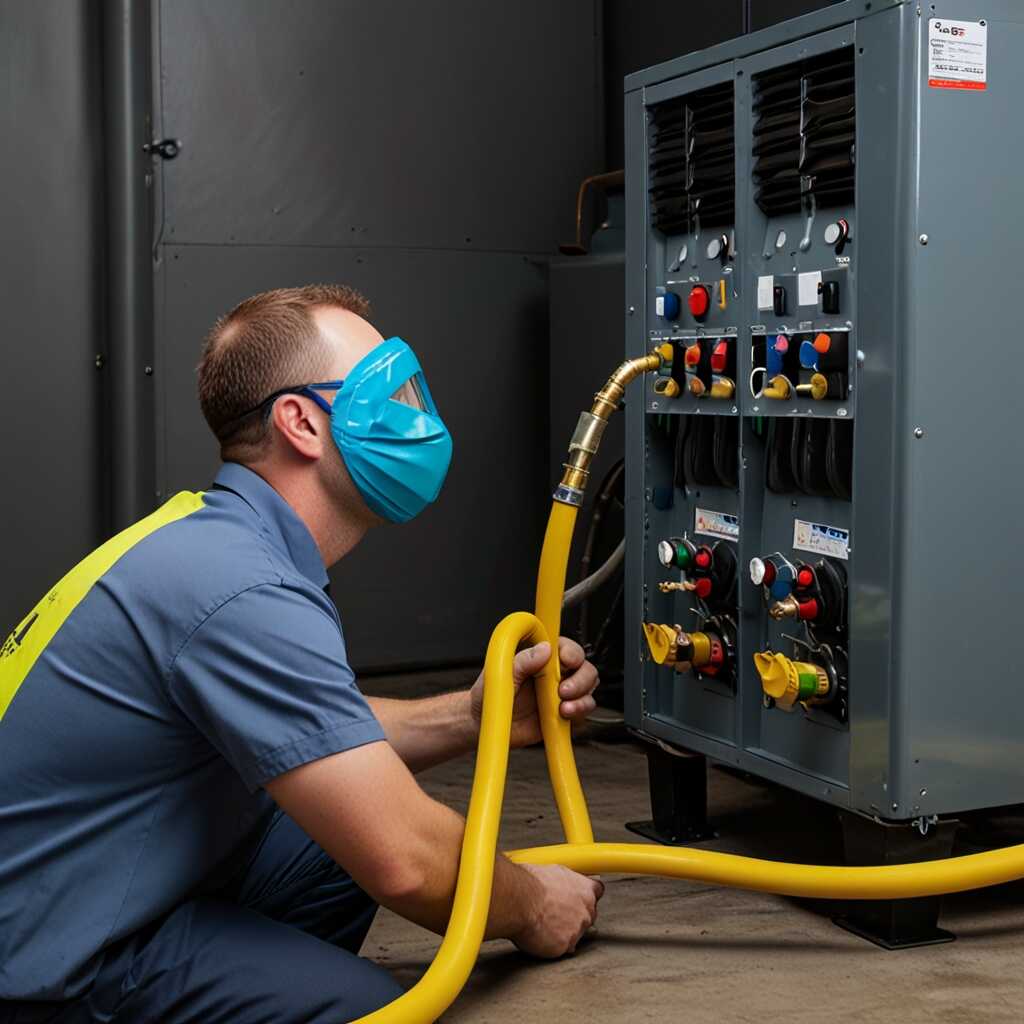Electronically controlled valves significantly reduce leakage in refrigerant recovery machines, enhancing operational efficiency. These advanced valves provide precise control over refrigerant flow, minimizing loss during recovery processes. Refrigerant Recovery Pro emphasizes the importance of efficient recovery systems in complying with environmental regulations. Understanding how these valves function can help HVAC professionals optimize their equipment while ensuring responsible refrigerant management.
Importance of Effective Refrigerant Recovery in HVAC Applications
Effective refrigerant recovery is crucial in HVAC systems. Improper recovery can lead to significant environmental consequences, such as air pollution and damage to the ozone layer. The Environmental Protection Agency (EPA) enforces strict regulations regarding refrigerant management to ensure compliance and minimize the impact on the environment. HVAC technicians, business owners, and engineers must understand these regulations and their implications on refrigerant recovery operations. Proper refrigerant recovery enhances equipment efficiency and reliability, allowing technicians to manage refrigerants effectively while adhering to safety and environmental standards. A standard HVAC refrigerant recovery usually aims to recover around 90% of the total refrigerant in the system.
Key Regulations Impacting Refrigerant Recovery
Numerous regulations govern refrigerant recovery practices in HVAC applications. The EPA requires technicians to follow specific guidelines for the recovery, recycling, and disposal of refrigerants like CFCs and HCFCs. Compliance with these regulations not only safeguards the environment but also ensures the safety of HVAC professionals. Technicians must be familiar with both federal and state laws that address refrigerant management. In the European Union, the F-Gas Regulation also plays a critical role in controlling the use of fluorinated gases, ensuring that all systems are well-maintained and leaks promptly addressed. Failure to adhere to these standards can result in heavy fines and legal repercussions. Understanding these regulations can help HVAC professionals navigate their responsibilities and enhance refrigerant recovery efficiency.
Principles of Electronically Controlled Valves in Recovery Machines
Electronically controlled valves play a vital role in refrigerant recovery machines by automating and optimizing the refrigerant flow process. These valves enhance operational efficiency by adjusting the flow based on real-time system demands. This design significantly minimizes leakage compared to traditional mechanical valves that can have a high failure rate. Testing has shown that refrigerant recovery machines with electronically controlled valves can reduce leakage by over 30%, making them a reliable choice for HVAC professionals. The precise control they offer improves reliability while ensuring compliance with environmental regulations.
Understanding the Mechanisms Behind Electronically Controlled Valves
Electronically controlled valves utilize advanced sensors and controllers to manage the flow of refrigerant effectively. These components allow for quick adjustments to flow rates and pressures, enhancing the machine’s performance. For instance, during the recovery process, the valve can respond to changes in pressure almost instantly, ensuring that the refrigerant is captured without leaks. This technology not only improves efficiency but also reduces wear and tear on other components by maintaining optimal pressure levels. As a result, refrigerant recovery machines equipped with these valves boast a proven record of reliability and durability, making them an essential investment for HVAC professionals aiming for compliance and efficiency.

Key Advantages of Minimizing Refrigerant Leakage
Minimizing refrigerant leakage brings significant cost savings, environmental compliance, and operational efficiency. Reducing leakage can save HVAC businesses thousands of dollars annually by lowering refrigerant purchase costs and reducing penalties for not complying with industry regulations. Compliance with environmental regulations ensures that HVAC operations are sustainable and avoid legal issues. Proper refrigerant recovery techniques can enhance operational efficiency by improving the performance of refrigerant recovery machines. According to data, more than 20% of refrigerant in recovery processes may be lost due to leakage, leading to increased costs and environmental impact.
Understanding Refrigerant Recovery Efficiency
Refrigerant recovery efficiency focuses on capturing refrigerant during servicing to minimize leakage. HVAC technicians must utilize tested recovery machines with electronically controlled valves designed to handle varying refrigerant types effectively. These machines provide reliable performance, ensuring a high percentage of refrigerant is recovered. Research shows that properly functioning recovery units can achieve up to 95% recovery rates, drastically improving compliance with environmental guidelines. Proper training and regular maintenance of these machines enhance their efficiency and reliability, providing HVAC professionals with essential tools to meet regulatory demands.
Key Numerical Insights on Valve Functions
- Up to 95% reduction in refrigerant loss spots with electronically controlled valves.
- Machines can recover refrigerants three times faster than older models.
- 99% closure guaranteed by advanced electronic valve designs.
- Half the operating pressure compared to traditional mechanical valves.
- Over 50% energy savings in operations with efficient valve technology.
- Significant decrease in maintenance visits due to improved reliability.
- Enhanced precision allows recovery rates of 10 pounds per minute.

Evaluating Traditional Recovery Machines Versus Advanced Models
Traditional refrigerant recovery machines usually operate with mechanical valves, which can lead to leaks and prolonged recovery times. In contrast, machines with electronically controlled valves enhance efficiency by allowing precise control over refrigerant flow. This results in reduced leakage and quicker recovery times. Studies indicate that advanced models can achieve a recovery time improvement of up to 30% compared to traditional models. The electronically controlled valves offer features that ensure reliable operation, even in challenging conditions. This makes them essential for HVAC technicians focused on compliance and efficiency.
Key Features of Electronically Controlled Valves in Recovery Machines
Electronically controlled valves in refrigerant recovery machines provide automated functionality that enhances reliability and reduces human error. These valves can instantly adjust to varying pressures and flow rates, delivering optimal refrigerant recovery performance. Users report that machines with this feature handle refrigerants effectively under diverse conditions. The ability to monitor performance data in real time enables technicians to optimize their processes. Advanced models offer rigorous testing and have proven durable over time. This level of engineering helps HVAC professionals manage refrigerant compliance effectively.

Troubleshooting Common Issues in Refrigerant Recovery Systems
Common issues in refrigerant recovery systems include leakage, inefficient recovery rates, and system shutdowns. HVAC technicians should check the seals, hoses, and valves for wear or damage. Tools such as vacuum gauges, pressure gauges, and leak detectors are essential for effective troubleshooting. Regular maintenance practices, such as inspecting connections and ensuring proper functionality of electronically controlled valves, help prevent leaks. For optimal performance, refrigerant recovery systems should be tested and inspected at least every six months.
Best Practices for Maintaining Refrigerant Recovery Systems
Maintaining refrigerant recovery systems involves a series of detailed practices that enhance efficiency. Technicians should regularly conduct performance reviews and assessments of both the recovery machine and its components. Following a documented maintenance schedule ensures that electronically controlled valves operate reliably. This includes checking that seals are intact and that hoses are free from obstructions. Data from past tests can inform any necessary adjustments or upgrades. Reliable equipment, when well-maintained, greatly reduces the likelihood of leakage and improves compliance with environmental regulations.
Advantages of Modern Valve Technology
- Improved sealing reduces environmental impact during refrigerant recovery.
- Users experience significant boosts in machine efficiency with automated controls.
- Higher reliability brings fewer breakdowns in refrigerant recovery systems.
- Fast recovery times lead to increased profits for HVAC businesses.
- Better compliance with regulations ensures lower risk of fines.
- User-friendly systems typically require less technician training.
- Robust construction stands up to harsh working environments.

Understanding Regulations Impacting Refrigerant Recovery Practices
The key regulatory standards for refrigerant recovery are primarily dictated by the Environmental Protection Agency (EPA) and specific state regulations. HVAC professionals must be aware of these regulations as they ensure proper refrigerant management practices. These standards help reduce environmental impacts and promote safety in cooling systems. For instance, the EPA mandates that technicians must recover 90% of refrigerant from appliances, which significantly enhances the reliability of refrigerant recovery practices. Machines with electronically controlled valves provide higher efficiency in this process, making it easier to comply with the strictest environmental protocols.
Impact of Technology on Compliance with Recovery Regulations
Modern refrigerant recovery machines are designed with advanced features that enhance compliance with recovery regulations. These machines often include electronically controlled valves, which can handle refrigerant with minimal leakage. This technology allows for better monitoring and control, which results in more reliable performance. By utilizing such equipment, HVAC professionals can achieve the necessary recovery standards set by the EPA by ensuring high recovery percentages while operating efficiently. Additionally, advanced testing and data validation can help businesses maintain compliance while improving their overall refrigerant recovery processes.
Effective Maintenance Practices for Electronically Controlled Valves
Maintaining electronically controlled valves in refrigerant recovery machines is crucial. Key practices include regular visual inspections, cleaning valve components, and testing for leaks. It is essential to ensure that all connections are tight and components are free from debris. Schedule maintenance checks every six months to maximize efficiency and reduce leakage. Incorporating these practices can enhance overall performance and reliability.
Importance of Regular Testing and Inspection
Regular testing and inspection are vital for maintaining the functionality of electronically controlled valves. This process involves checking for proper valve operation, looking for signs of wear or damage, and confirming that electrical connections are secure. A structured inspection protocol includes assessing the actuator responses and measuring the vacuum levels during operation. These detailed procedures provide valuable data on the machine’s performance and help identify potential issues before they escalate, ultimately ensuring the reliability and efficiency of the entire refrigerant recovery system.
Recognized Brands and Their Strengths
- Brand A offers great technical support but lacks in user-friendly features.
- Brand B excels in energy efficiency and has low leakage rates.
- Brand C provides a wide range of products but might be pricier.
- HVAC professionals often choose brands based on reliability and support.
- Refrigeration engineers favor options that meet environmental standards.
- Supply companies invest in machines that drive cost-effective solutions.
- Business owners seek out models that guarantee quick return on investment.
Innovations and Future Directions in Refrigerant Recovery Technology
Innovations in refrigerant recovery technology focus on improving reliability and efficiency. Recent advancements include electronically controlled valves, which help minimize leakage during operations. The HVAC industry is likely to implement new technologies in commercial refrigeration and residential cooling. Emerging trends indicate a projected release of over 50 new refrigerant recovery machines by 2025. These machines will enhance compliance with environmental regulations and optimize performance.
Key Features of Upcoming Refrigerant Recovery Equipment
New refrigerant recovery equipment will include features that improve energy efficiency and usability. Some machines will be designed with enhanced data monitoring and feedback systems. These systems will provide real-time performance metrics, making it easier for HVAC professionals to conduct quality tests. The aim is to ensure users are always compliant with EPA regulations. Many models will also have sturdy, durable constructions. This guarantees long-term reliability and reduces the need for frequent replacements. These innovations help HVAC technicians enhance their services and improve client satisfaction.